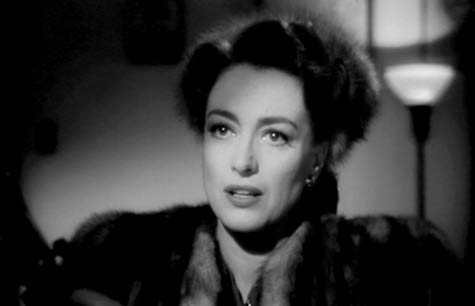
In some ways, Joan Crawford might seem an odd choice for a hard luck lady of noir. Unlike many of the actors I’ve profiled in this series—people like Peggie Castle or Barbara Payton—who somehow missed popular success altogether and died penniless and forgotten, Crawford was a major success. In fact, as the silent era gave way to sound in the late 20s, Crawford supplanted Mary Pickford as the queen of Hollywood. For a while there in the early thirties, there was virtually no bigger star in the movies. Who ever had better luck?
Alas, Crawford’s luck ran out. By the end of the thirties, the public seemed not only to have moved on from her, it seemed to have rejected her, to cast her off. She was, the papers said, “box office poison.” In 1943, MGM, the studio she had helped power to success, let her go—something that would have been unthinkable just a few years before. By that time, however, Crawford was sick of the place and wanted to move on. She did, and arrived at Warner Brothers where she made most of her real contributions to the genre of film noir. She bounced back in this new format—winning an Oscar for Mildred Pierce and recapturing her box office luster for a while. But by the fifties, her fortunes had turned again. Fewer and fewer good roles came her way. Along with her old rival Bette Davis, she turned herself in a ghoul for horror films in the sixties. She hated the work, hated what had become of her career.
She died in 1977. She’d been married four times (the first three ended in divorce, the fourth ended with her husband’s death in 1959) and had adopted five children. After her death, her eldest daughter Christina (whom Crawford had explicitly disinherited in her will) wrote the memoir Mommie Dearest. The book painted a devastating portrait of Crawford as a psychotic monster—an abusive ghoul not so far removed from some of those late career horror roles. Although the book’s caricature of Crawford was disputed by her other children, as well as several of Crawford’s friends and family, the book became a bestseller (and later, a widely panned movie starring Faye Dunaway). However accurate Christiana’s book may or may not have been, what is inarguable is that it fixed an image of Crawford that has, in some ways, replaced the image created by her movie roles. For many people who have never seen her films, Joan Crawford is Mommie Dearest before she’s anything else.
I obviously can’t even attempt to arbitrate the internal dynamics of the Crawford family. What we can say for sure is that Joan Crawford was a complicated, even tormented, woman. Born in Texas as Lucille Le Sueur, she endured poverty and abuse early in her life, and then worked her way up through dance halls and chorus lines. (What the Village Voice once called “ancient Hollywood gossip” had it that she also did some sex work early on as well, though this has never been proved conclusively.) Once she got into the movie business she had to fight to get parts from producers who didn’t believe in her. Lucille Le Sueur made herself into Joan Crawford, and she turned Joan Crawford into one of the most famous people in the world. And then she saw Joan Crawford fall from the fickle good graces of millions of people. Hard luck lady indeed.
Here’s the thing: whatever we know—or think we know—about Joan Crawford the person, Joan Crawford the movie star was Great with a capital G. In noir, she is Suffering Saint Joan. Sometimes a good woman, sometimes a bad woman, and sometimes a thoroughly mixed-up woman, she was at all times called upon to suffer. It was a role, sadly, that she seemed born for.
Essential Joan Crawford Noir:
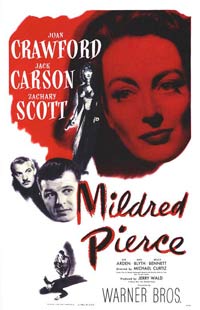 1. Mildred Pierce (1945)
1. Mildred Pierce (1945)
Crawford’s first film for Warner Brothers shot her back to the top. This Michael Curtiz masterpiece was liberally adapted from the novel by James M. Cain—turning a mother-daughter drama into a murder mystery. Mildred Pierce (Crawford) is a striving single mother who is loathed by her greedy monster of a daughter (Ann Blyth). Although there’s a murder to frame the story, its heart is the relationship between the hardworking, loving mother and the hateful little monster of a daughter. Crawford is excellent as a woman who is strong and smart but also stubbornly needy. One of her great performances and one of the great noir dramas.
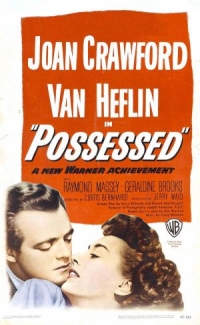 2. Possessed (1947)
2. Possessed (1947)
Crawford plays Louise Howell who, as the film begins, is found wandering the streets of Los Angeles in a daze asking random people on the street if they’ve seen a man named David. Who is Louise? And who is this David she’s looking for? Once Louise is put in the “Psychopathic Ward” of a hospital, we start to get some answers. Possessed continues the noirification of Crawford that began Mildred Pierce, and, in many ways, kicks off the psychotic phase of her career. She’d played neurotics before, but here the drama is centered around watching her lose her mind. We’re trapped in her perspective—quite literally in moments throughout the film where the camera adopts her POV—and forced to identify with her pain and confusion. Atmospherically directed by Curtis Bernhardt, with a brilliant turn by Suffering Saint Joan, this is another noir masterpiece.
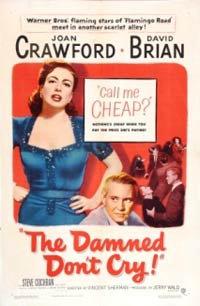 3. The Damned Don’t Cry (1950)
3. The Damned Don’t Cry (1950)
This one could have been called Requiem For A Gold Digger. This is Joan in full on broad mode, hatching schemes and changing men like she’s trying on shoes. The film takes the scrappy social climbing Joan of the early thirties (the one who, at MGM, was played for laughs or pathos) and darkens her story several shades of noir. The film isn’t a simple cautionary tale though. Indeed, it puts Joan in a world where she has no choice but to climb a ladder of success that ultimately leads to doom. As she tells one would be boyfriend, “You're a nice guy. But the world isn't for nice guys. You've got to kick and punch and belt your way up because nobody's going to give you a lift. You've got to do it yourself, because nobody cares about us except ourselves.”
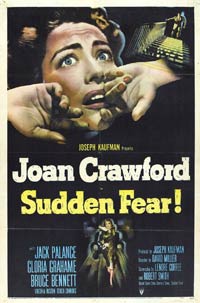
4. Sudden Fear (1952)
Joan was back to being a victim in this RKO drama based on the novel by Edna Sherry. She’s a middle-aged playwright being stalked by a psycho actor (Jack Palance) and his old girlfriend (Gloria Grahame). If you want more out of a movie than a showdown between Joan Crawford, Jack Palance, and Gloria Grahame then you need to rethink your priorities.
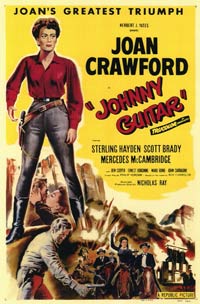 5. Johnny Guitar (1954)
5. Johnny Guitar (1954)
This noir Western from director Nicholas Ray is one of the weirdest movies ever made in Hollywood. It takes place in a supremely artificial west—mostly on one big set—with Crawford’s saloon owner Vienna going to war with a land baron’s nutcase daughter named Emma Small, played by Mercedes McCambridge. File this one under Not For Every Taste, but its fans include Martin Scorsese and Roger Ebert, and it’s been championed by Queer theorists and auteurist critics alike. Is it a feminist western? A camp ride? Whatever the hell it is, you have never seen anything like it and, if you go into it with that mindset, it’s pretty damn entertaining.
Jake Hinkson, The Night Editor, is the author of The Posthumous Man and Saint Homicide.
Read all posts by Jake Hinkson for Criminal Element.

There was no space for this in the piece above, but I wanted to tell my favorite backstage story about Crawford. This comes via an interview I did with the writer Raymond E. Feist a few years about his father, the director Felix E. Feist. By the late 50s Warner Brothers was eager to ditch Crawford, and encouraged director Felix Feist to “make her look bad” on the film THIS WOMAN IS DANGEROUS. Feist, like most people who knew her, didn’t particularly like Crawford, so he did as he was told. After three days of shooting, however, he called his producer Bob Sisk and told him, “Bob, you’ll have to tell the studio guys to find another way to get her out of her contract. This womancan’t give a bad performance.”
I enjoyed this, Jake. Mildred Pierce alone earns her a place in the film noir hall of fame, of course. Sudden Fear is one I like a lot, too, and I am one of the weirdos who LOVES Johnny Guitar. Nicely written piece, as always.
Перезвоните мне пожалуйста 8 (499) 322-46-85 Юлия.